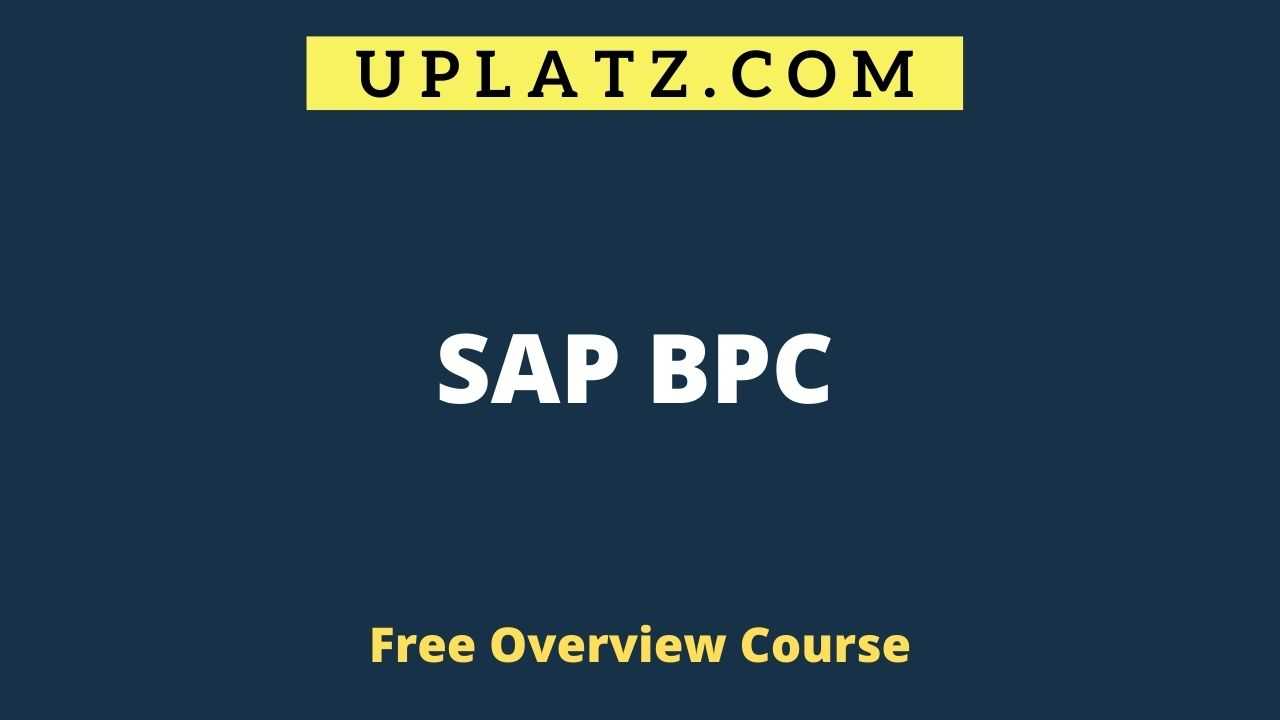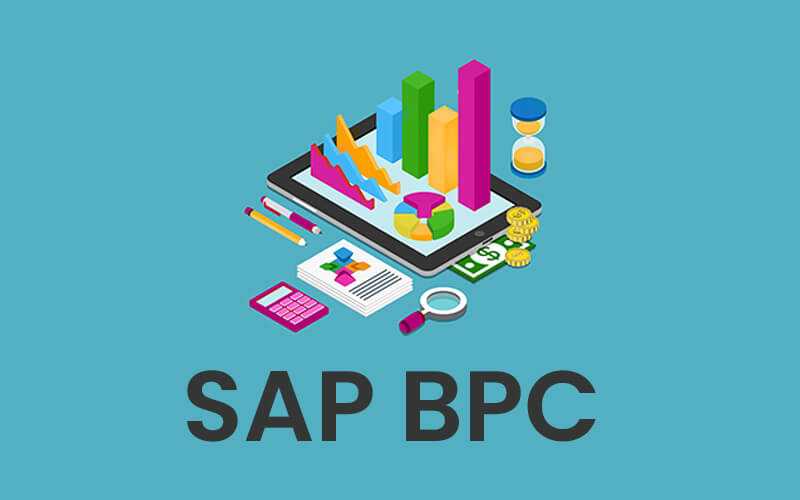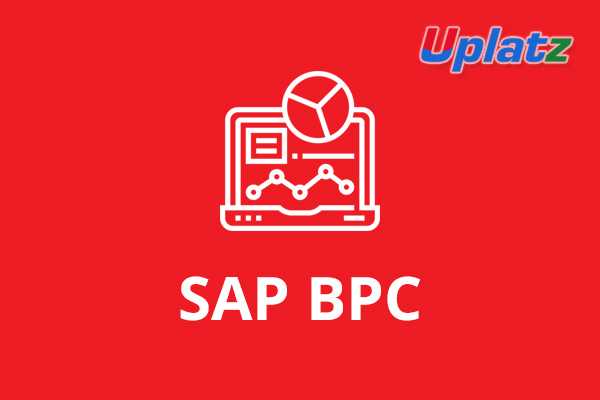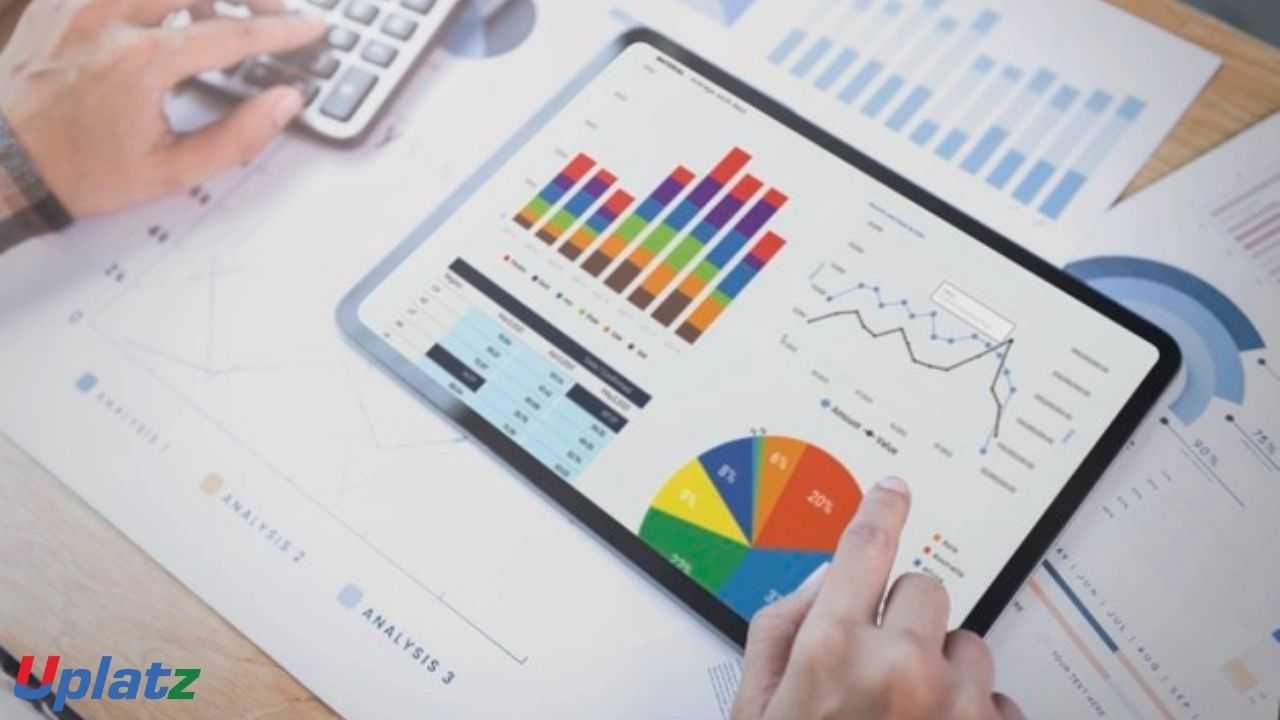Overview Course - SAP BPC
Learn about financial planning, budgeting, and forecasting and such important attributes. View Course Curriculum
Price Match Guarantee
Full Lifetime Access
Access on any Device
Technical Support
Secure Checkout
Course Completion Certificate
View Course Curriculum
Price Match Guarantee
Full Lifetime Access
Access on any Device
Technical Support
Secure Checkout
Course Completion Certificate
 46% Started a new career
Enroll Now
46% Started a new career
Enroll Now
-
 73% Got a pay increase and promotion
73% Got a pay increase and promotion
Students also bought -
-

- SAP BPC (basic to advanced)
- 30 Hours
- GBP 12
- 199 Learners
-

- SAP BPC (Business Planning and Consolidation)
- 30 Hours
- GBP 12
- 1504 Learners
-

- SAP BPC Classic
- 40 Hours
- GBP 12
- 1720 Learners

This is an overview course on SAP BPC while the complete detailed-level SAP BPC course is available at - https://training.uplatz.com/online-it-course.php?id=sap-bpc-business-planning-and-consolidation-7. SAP BPC (Business Planning and Consolidation) is a module provided by SAP that includes everything in one package that any organization needs to run a business successfully focusing on financial planning, budgeting, and forecasting and such important attributes.
Key features of SAP BPC module include:
a) Unified - Planning and Consolidation in one product, single application lessens maintenance, enhance data integrity, and simplifies deployment, it also enables flexible planning & consolidation functions
b) Owned and Managed by Business Users - Business users manage processes, models & reports with little IT dependence.
c) An open, adaptable application - Extends the value of your investment in both SAP and non-SAP environments.
d) Familiar, Easy to use - SAP BPC is easy to use and support native Microsoft Office tools (e.g. Excel) and web browsers accessing a central database.
e) Align Financial and Operational plans - It helps to determine financial goals and operational plans with strategic objectives.
f) Reduce budget cycle time - BPC helps to reduce budget cycle time.
Attributes of SAP BPC module are:
1) Strategic Planning - It helps management team to formulate its vision, mission, core values, and objectives;
2) Budgeting - Plan of actions and expected operations of the organization over the next year and is done for proactive management and measurement of corporate performance,
3) Reporting - It ensures performance progress is monitored, problems are anticipated, and continuous improvement efforts are promoted;
4) Forecasting - is the act of predicting outcomes and is done throughout the year to reflect changes that have occurred both in the internal and external environment.
This is SAP BPC overview course by Uplatz while the complete SAP BPC training explains the core concepts of BPC in detail along with end-to-end implementation of SAP BPC module in the industry.
Course/Topic - SAP BPC overview - all lectures
-
Lecture 11 - BPC - EPM Add-in Overview
-
Lecture 15b - BPC - Master Data Load
-
Lecture 17 - BPC - Reclasssification
- •Learn how to position SAP Business Planning and Consolidation.
- • Plan and Report in Analysis for Office version for Excel.
- • Use business process flows and work status for planning scenarios.
- • Learn how to design BPC Embedded using best practices in a comprehensive end-2-end setting.
- • Learn to configure the SAP BPC planning environment as an administrator, advanced reporting techniques, tools and application configuration, etc.
This SAP BPC Overview training course is designed for mastering the SAP BPC modules.
This SAP BPC Overview training course is meant for clearing the SAP Certified Application Associate-SAP Business Planning and Consolidation 10.1 and 11.0exam.
The SAP Business planning and Consolidation application is meant to support all sort of operational, and finance related activities in an organization. SAP BPC Consolidation is used to prepare consolidated data for the benefit of an organization.
The SAP BPC Overview Course module details about SAP Business planning and consolidation application and its integration with Sap or non-sap data. The SAP BPCOverview course details about the key components of SAP BPC tool, business planning, budgeting and cloud deployment within the premises.
The SAP BPC course also covers technical module such as business rules, architecture, process control, Models, BW integration, EPM add-in and administration.
Uplatz provides appropriate teaching and expertise training to equip the participants for implementing the learnt concepts in an organization.
Uplatz Course Completion Certificate will be awarded upon the completion of the SAP BPC Overview course training.
The SAP BPC certification exam verifies whether the participants possesses sound knowledge and can prove their competencies in the area of SAP Business objects planning and consolidation and able to implement the knowledge practically in projects.
Below given are the certification Details of SAP Certified Application Associate-SAP Business Planning and Consolidation 10.1 and 11.0
• Certification Level: Associate
• Exam Name: SAP Certified Application Associate-SAP Business Planning and Consolidation 10.1 and 11.0
• Exam Code: C_EPMBPC_11
• Exam Mode: Online
• Total Number of Questions: 80
• Pass Score: 60%
• Time Duration: 180 Minutes
• Exam Price: $550
The SAP BPC Consultant draws an average salary of $83,974 per year depending on the competencies, knowledge and hands-on experience.
The SAP BPC Consultants are recognized across the globe. The SAP BPC Consultant are known formastering budgeting, forecasting and finance consolidation ability in an organization.
The SAP BPC certification is targeted to those participants who are from finance or business background and excel as SAP BPC consultant
The following are the job titles:
• SAP BPC Expert
• SAP BPC Associate
• Finance Consultant
• BPC Finance Consultant
• SAP BPC Associate
The SAP BPC online course provides you with an opportunity to explore career opportunities as SAP BPC Consultant.
#1. What is BPC?
Ans. BPC stands for Business Planning and Consolidation. BPC is used for both Planning and Consolidations, unlike IP, which is used for only planning.
#2. When BPC 7.5 NW is available?
Ans. The 7.5 version is currently in the ramp-up stage and should be available in a few months. I am not sure of the exact month.
#3. What are the two versions available for SAP BPC?
Ans.
· SAP BPC NetWeaver
· BPC MS
#4. BPC for NW has an aggregation level or not, Is BPC an application on top of SAP-IP?
Ans. BPC and IP have completely different architecture. BPC doesn’t use aggregation levels or filters. BPC and IP have no relation and thus, cannot be compared. BPC uses various script logics, business rules for doing the planning. Manual planning can be done with input schedules. The input schedules are on excel platform and are quite versatile. You can use BPC functionalities along with native excel functionalities for better design of the input schedules.
#5. What about BPC in the consolidation part?
Ans. BPC comes with pre-delivered components for consolidation, which can be leveraged on. There are a few business rules, which make the consolidation process easier.
#6. What is the concept of plan data from BPC?
Ans. The concept of planning is the same as you have in any other tool. The functional side of the planning remains the same. However, the tool differs. The way you configure a planning scenario will be much different than any other planning tool. Unfortunately, it will not be feasible to address this in the forum. You can definitely go through the study materials for a better understanding.
#7. BPC for NW needs to install .NET application server and Web server or not?
Ans. Yes, You can have a look at the installation guide available on the marketplace for detailed requirements.
#8. What are the key benefits of using SAP BPC with NetWeaver?
Ans.
Star Schema for Exceptional Reporting − SAP BPC uses NW InfoCubes to store the data. The dimension model used is extended Star Schema so it makes BPC with the NW system an exceptional system for reporting.
No Database Dependence Version − BPC NW version is not dependent on database version and can run common databases like DB2, Oracle, SQL Server, etc.
BW Accelerator Support − SAP NetWeaver BW accelerator tool is an additional feature that can be used to enhance the performance of reporting in the system even if you are using large datasets. It indirectly helps in saving the cost for a company as less number of report performance issues are reported.
Badi Development and ABAP Support − SAP BPC with NetWeaver allows you to use ABAP programming to develop K2 script logic. It enables to create business add-in BAdi interface in the back-end system, which can be called later from script logic developed in BPC system. It helps in solving the complex business requirements and reducing the development time for an organization.
#9. What is the BPC client tool? And If I planning on the BEx report, I have to create an aggregation level for planning data or not?
Ans. BPC client sits on the client machines, from where; you will be doing the design. There are mainly 3 interfaces available - BPC Admin, BPC Office, and BPC Web. BPC Office, in turn, has 3 interfaces - Excel, Word, PowerPoint. These interfaces can be used for various requirements.
#10. Can you debug the data manager package?
Ans. UJD_TEST_PACKAGE.You must specify the USER ID. The DM package can be selected with F4.
#11. What are scoping commands?
Ans.
The following keywords can be used to modify the scope: *XDIM_MEMBERSET Overwrites the scope for that dimension *XDIM_ADDMEMBERSET Add members to the scope of that dimension *XDIM_FILTER Filters the members of the scope of that dimension *XDIM_MAXMEMBERS Specifies the maximum number of members that should be included in one query (per dimension)
#12. What are the key advantages of using BPC MS?
Ans.
Dimension Logic − This can be configured in the BPC system using simple mathematical formulas.
Business Rules − This allows you to create rules in BPC system to perform specific functions.
K2 Script Logic − This is used to perform some specific functions which can’t be achieved using out-of-box functionality to meet the business requirements. You can create K2 script logics to perform certain functions, which can be performed in a standard system.
#13. What are the system variables?
Ans. %USER% - Returns current SAP Business Objects Planning and Consolidation User %APPSET% - Returns current SAP BusinessObjects Planning and Consolidation AppSet (Application Set) %APPLICATION% - Returns current SAP BusinessObjects Planning and Consolidation Application %YEAR% - Returns current calendar year.
#14. What is the difference between EVGTS and EVANS?
Ans. EVGTS: The EVGTS (Get value and scale) function retrieves a data value based on the specified members, and scales the value if the scale property is enabled on the dimension. The report templates provided in the sample application set have a scale reference in the Control Panel area of the template.
EVSND: EVANS This Send function references another cell and sends its value to the database when you select Send and Refresh Schedules. The parameters specify the dimensions that identify where the data value is to be sent in the database. EVSND returns the value from the database to the referenced cell. You do not need to add any EVGET functions to the sheet to return values to the cell. Since the values are returned to the referenced cell, BPC sends only the cells that have changed since the last send in the current session. By putting the formula in the EVANS cell and not in the input cells, you decrease the chances of your formulas getting overwritten or erased. To further protect the formulas, you may want to hide the EVSND cells in the input schedule. This function takes members that not specified from the current view settings.
#15. What is the difference between DRILLDOWN and DRILL THROUGH?
Ans. Drill down is different than drill through. Drill down is used to drill down on member data within dimensions. You can drill down on members in a worksheet, or you can drill down on charts and graphs. Drill down is conducted within one report in the Excel interface whereas drill through is a 'jump' outside of the Excel Interface.
#16. What are the options of DRILL THROUGH?
Ans. Jump to any website Jump to a BW query Jump to ECC code.
#17. What steps are in processing a dimension?
Ans. Processing a dimension will execute the following steps:
· Validate Hierarchy.
· Validate Dimension member formulas.
· Update member data into BW.
· BW Attribute change run.
#18. What fields will be in the Distribution Template?
Ans. A Distribution Template may contain the following fields:
· BOOK: the title of your distributed book.
· SECTION: denotes the beginning of a section.
· REPNAME: report filename, location and title (can also be for Input Schedules).
· FIXKEY: sets dimension members to the fixed values when generating the report. For example, you can ensure that a report runs for 2008.TOTAL and ACTUAL.
· VARKEYS: lists the dimensions and dimension members that should vary for each report that will get created.
For example, if you want to create a new offline report for each Entity/Cost Center/etc, you would specify that dimension as a Very Key.
#19. What are the key components in BPC architecture?
Ans.
Requirement − SAP NetWeaver ABAP 7.3 or 7.31
Database − Any of the above versions of SAP NetWeaver support.
Operating System − Any supported version of the SAP NetWeaver system and database engine.
#20. Which databases are supported by SAP BPC with the NetWeaver version?
Ans. This layer is responsible to store all the data in the database. SAP NW back-end system is responsible to create objects and data stored for BPC system. NetWeaver supports most of the databases like SQL Server, DB2, Oracle, and many more.
#21. What is the Model in SAP BPC?
Ans. To meet the Business Planning and Consolidation requirement of an organization, you need to build a model in an environment, which is defined as a collection of several dimensions.
#22. What is the use of Logic Scripts in SAP BPC?
Ans. Logic Scripts is defined as a set of SQL or MDX programming structures to perform some customized functions for flexibility and manage data models. When some specific requirements are not achieved using business rules, those can be met by the use of Logic Scripts.
#23. While creating a legal consolidation application, which of the dimensions needs to be created in BPC?
Ans.
C_Acct (A) − For maintaining charts of account.
C_Category (C) − To define the category.
Groups (R) − Like GROUP A (USD), GROUP B (EUR), and GROUP C (RMB).
Entity (E) − It contains the business unit used to derive the process.
C_Datasrc (D) − Data Source Dimension.
IntCo (I) − It determines the level of the entity hierarchy at which level the elimination needs to be performed.
Time (T) − Time in all dimensions.
Flow (S) − To keep track of movements in Consolidation.
#24. What is the use of dimension - R_Acct (A), while creating a Rate Application in BPC?
Ans. R_Acct (A) is used for maintaining different types of Rate.
#25. Which design models are available in SAP BPC to fulfill the business requirements?
Ans.
· Standard Model
· Embedded Model
#26. How the Standard model is different from the Embedded BPC design model?
Ans. Embedded model is different from the Standard model and includes data access to all community users. For the Embedded design model, initial versions used were SAP BW Integrated Planning and Planning Application Kit i.e. BW-IP and PAK.
In the Standard Model, the BPC environment contains the BPC applications or models and each model generates a BW InfoCube which is hidden.
#27. What is the use of the Transformation file? What are the different sections in a Transformation file?
Ans. Transformation file provides the mapping of fields from BW to BPC and is an excel file in BPC. It contains transaction data from InfoObjects in BW with BPC dimensions defined in the administration console.
There are three sections defined for mapping file −
Options − Contains the general settings.
Mapping − Used to assign dimension in BPC system with a source column in BW InfoObject.
Conversion − Contains the link of other Excel sheets to apply the conversion routine.
#28. What is the use of a conversion file? Name different sections in a conversion file?
Ans. A conversion file is used to apply the conversion rules for the BPC dimension and is an Excel file. It contains three sections −
- External − Contains the value from an external source.
- Internal − Contains the value it should be having for the BPC dimension.
- Formula − Defines the conversion formula applied to each record.
#29. What are the different methods that can be used to create reports and input schedules in Business Planning and Consolidation?
Ans.
· Using Default Templates
· EvDRE Builder
· Drag and Drop Interface
· Blank workbook
#30. Have you used any default templates in BPC for reporting purposes? Name a few of the default templates?
Ans.
|
totals by Account |
This custom report contains an Account dimension with subtotals in rows and any dimension across in columns. |
|
Variance |
This custom report contains any dimension in rows and categories comparison in columns. It also features Variances calculation (both amount and percentage). With both YTD and Periodic boxes. |
|
Consolidating |
This custom report contains any dimension in rows and Entity type members across in columns with hierarchy. |
|
Comparative X |
This custom report contains any dimension in rows and categories comparison in columns and also retrieves the Last Year same period data. With both YTD and Periodic boxes. |
|
Comparison with 3 -year |
Year over Year comparison. |
|
Drill in Place |
This template performs drill in place. |
|
Nested |
This allows any two-dimension to be nested in a row and the third dimension in the column. |
|
Sort on value |
This template performs the sort of total value. |
|
Drill Dimension |
This allows using the drill in one dimension to others. |
#31. How can you migrate EvDRE reports created by BPC 7.5 Excel to BPC 10.0?
Ans. Go to EPM Ribbon → More → EvDRE Migration.
#32. What is the syntax for Dimension logic? Which operators can be used in Dimension logic?
Ans. To define the member dimension formula, you have to put a Square bracket around the dimension and there is dot between two.
[PRODUCT].[PRODUCT1] – [PRODUCT].[PRODUCT2]
[SALES].[SALES1] / [SALES].[SALES2]
Standard Arithmetic functions have to be used in dimension formula - addition (+), subtraction (-), multiplication (*), division (/) - are used in SAP NetWeaver.
#33. What are the requirements to perform simple currency conversions and complex currency conversions?
Ans.
Simple Conversion
· There should be a Rate application where you store the exchange rates.
· You should have an account dimension, which includes RATETYPE.
· Entity dimension should include a property CURRENCY.
· FXTRANS logic should be available and DEFAULT logic should include a call to FXTRANS logic.
· Entity dimension should include the property TRANSALATE_TO.
Complex Conversion
· There should be a Rate application where you store the exchange rates.
· Application should contain a CURRENCY type dimension.
· There should be property REPORTING for the CURRENCY dimension.
· Entity dimension must include the property CURRENCY.
· Account dimension must include property RATETYPE.
· FXTRANS logic should be available.
· DEFAULT logic should include a call to FXTRANS logic.
#34. What is the use of work status? What are the key attributes in defining work status?
Ans.
Work status is used to lock a region of data in a model. This is used to override the user’s member access privilege to write to a particular region.
There are multiple dimensions defined for a region with one property called as OWNER. While defining the work status, the following are defined −
Work States − It belongs to the physical state of data.
Security − You can set different levels of security on changing data in the system –All or Locked. You can set who can change the work state − Manager or Owner.
Data Update − This defines how data will be updated by the customer.
Push − This option is used to push the same work state for all the children of a member.
#35. How is auditing done in SAP BPC? What are the different audit reports that can be pulled for audit purposes?
Ans. Audit functions allow you to create reports that contain a history of user sessions and system information.
You can create Audit reports on the following topics −
Business Process Flows − You can create these reports in BPF.
· Standard
· Step
· Audit
Security − You can create these reports in Security.
· User
· Team
· Task Profiles
· Data Access Profiles
· BPF
General − You can create these reports in general.
· Work Status
· Administration Activities
· Comments
· Data Changes
#36. What are the two sections in Custom Menu Template?
Ans. Custom menu content is defined by two sections in the custom menu template - Default section and Menu item section.
#37. Explain the parameters that can be used with the Custom Menu Template?
Ans.
|
Parameters |
Options |
|
NORMALSCREEN |
Value is True − It opens the custom menu in Excel interface. Value is False − It opens the custom menu in Standard Excel. |
|
HIDEEVTOOLBARS |
If Value is True − It will hide the Planning and Consolidation Toolbar. If Value is False − It will display the Planning and Consolidation Toolbar. |
|
CVLIST |
It is used to define the dimensions that have to be displayed on the top of the custom menu page. These dimensions can be changed into the report mentioned in the Custom menu. |
Menu Item section includes the following parameters −
- Menu Item − Text description that the user can select for the menu item.
- Actions − Highlight, custom menu function or menu command.
- Level − Level can be selected from section, item or sub-item.
- Parameters − For custom menu functions.
- Normal Screen − Default is a full screen. This is set to true, open custom menu on the normal screen.
- CV Override − This is used to change current view dimensions while switching applications
#38. What is the difference between Reporting Model and Driver and Rate Model?
Ans. We use reporting models for analysis purposes. Non Reporting modules include Driver and Rates model and are used for currency rates, price, ownership data, etc.
Types of Reporting Models −
· Consolidation
· Finance
· Generic
Types of Non-Reporting Models −
· Rate
· Ownership
#39. To perform intercompany elimination, which dimensions should be defined and what properties should be created for these dimensions?
Ans. To perform currency conversion and intercompany eliminations, you need a dimension type - Intercompany dimension (I). To execute intercompany elimination, an application should have the following −
- Dimension Type “I” for intercompany elimination.
- Dimension “I” should include a property ENTITY.
- The account dimension should include property ELIMACC.
- The entity dimension should include property ELIM.
- You should set the appropriate business tables.
- There should be a DPT package to execute intercompany logic that should be available.
|
Dimension |
Property |
Length |
Content |
|
Account |
ELIMACC |
20 |
Valid account |
|
Entity |
ELIM |
1 char |
It contains ‘Y’ or blank |
|
InterCompany |
Entity |
20 |
Entity Id w.r.t Intercompany member |
|
Currency |
Reporting |
1 |
‘Y’ or blank |









